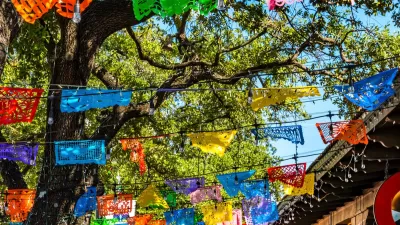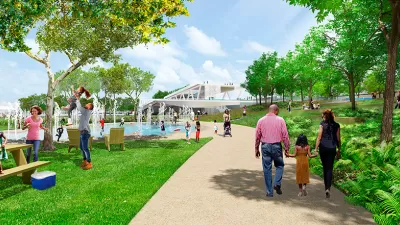Art and culture tend to be integral to helping disenfranchised communities self-identify, develop their identities, and organize around place-based issues. But its presence can also be used be used by real estate interests to market neighborhoods.
“On the west side of Prospect Park in Brooklyn, the neighborhood has been predominantly West Indian, but it’s changing. Maybe four [or] five years ago, there was an RIP mural that has been there for as long as I can remember, 15 to 20 years, and it was of a young black man who had gotten shot by a cop. And overnight, literally, overnight, some artist—I would presume someone new to the community—created a mural over that piece that was of a white girl catching a butterfly. The community—as you might imagine—was outraged, like, ‘we didn’t ask for this.’
It was a really bold statement, and it was interpreted as, ‘We’re here. We’re taking this place.’
All art is propaganda. It was a beautiful piece, and was executed really well, but was in such poor taste, and was a blatant disrespect to the community that folks—after graffiti-ing the [expletive] out of it—painted over it. I think the painting over it could be interpreted as, ‘No you don’t. You don’t get to do that. We may not be able to control [when] the rents go up, or who landlords are allowing into their building, but you can’t start to now, literally, change the face of public art in this community.’”
—Patrick Dougher, Groundswell
In the past, in historically disenfranchised neighborhoods that were tapped for new development, artist in-movers were sometimes considered the “first wave” in the gentrification process. Usually in the form of galleries, their spaces attracted newcomers of a different socio-economic group than neighborhood residents, which encouraged more newcomers and subsequent residential and commercial development.
In some neighborhoods, those spaces included non-commercial, community art spaces; and whether intentionally or not, their presence has been, and continues to be used by real estate interests to brand neighborhoods and make them more attractive to potential buyers. Like the Lower East Side of Manhattan in the 1980s, or Bushwick, Brooklyn today, the presence of an artistic community has hastened the chain reaction of higher income in-movers “discovering” a neighborhood, higher-end (and uncharacteristic to the neighborhood) commercial spaces opening, increased rent costs, and the displacement that follows. Unsurprisingly, resident hackles have been raised and sensitized to the appearance of galleries and other art spaces out of fear that displacement is in their future.
The other side of this reality is that art and culture tend to be integral to helping communities self-identify, develop their identities, and organize around place-based issues. Revolutionary organizations like the Black Panther Party in Oakland, art movements like Black Mask/Up Against the Wall Motherfucker, and community organizations like El Puente in Williamsburg and Banana Kelly in the South Bronx have all in one way or another used art to address local issues.
Because of the market and socio-political realities in New York City today, a lot of local issues often come back to gentrification and displacement, as they might have come back to redlining and the withdrawal of public services in the 1960s and 70s. And because talking about the presence of community art organizations and their effect on gentrification in New York City is largely a moot chicken/egg discussion, the task in most neighborhoods today is on lessening its effect. In a panel hosted this spring by arts organization Flux Factory and organized and moderated by its Column Shifting fellow Oksana Mironova, four representatives of New York City organizations discussed, among other topics, their employment of art and artists to empower residents in the face of gentrification.
FULL STORY: Art in the Face of Gentrification

Study: Maui’s Plan to Convert Vacation Rentals to Long-Term Housing Could Cause Nearly $1 Billion Economic Loss
The plan would reduce visitor accommodation by 25,% resulting in 1,900 jobs lost.

North Texas Transit Leaders Tout Benefits of TOD for Growing Region
At a summit focused on transit-oriented development, policymakers discussed how North Texas’ expanded light rail system can serve as a tool for economic growth.

Using Old Oil and Gas Wells for Green Energy Storage
Penn State researchers have found that repurposing abandoned oil and gas wells for geothermal-assisted compressed-air energy storage can boost efficiency, reduce environmental risks, and support clean energy and job transitions.

Private Donations Propel Early Restoration of Palisades Playground
Los Angeles has secured over $1.3 million in private funding to restore the Pacific Palisades playground months ahead of schedule, creating a modern, accessible space that supports community healing after recent wildfires.

From Blight to Benefit: Early Results From California’s Equitable Cleanup Program
The Equitable Community Revitalization Grant (ECRG) program is reshaping brownfield redevelopment by prioritizing projects in low-income and environmental justice communities, emphasizing equity, transparency, and community benefits.

Planting Relief: Tackling Las Vegas Heat One Tree at a Time
Nevada Plants, a Las Vegas-based nonprofit, is combating the city’s extreme urban heat by giving away trees to residents in underserved neighborhoods, promoting shade, sustainability, and community health.
Urban Design for Planners 1: Software Tools
This six-course series explores essential urban design concepts using open source software and equips planners with the tools they need to participate fully in the urban design process.
Planning for Universal Design
Learn the tools for implementing Universal Design in planning regulations.
Ascent Environmental
Borough of Carlisle
Institute for Housing and Urban Development Studies (IHS)
City of Grandview
Harvard GSD Executive Education
Toledo-Lucas County Plan Commissions
Salt Lake City
NYU Wagner Graduate School of Public Service





























